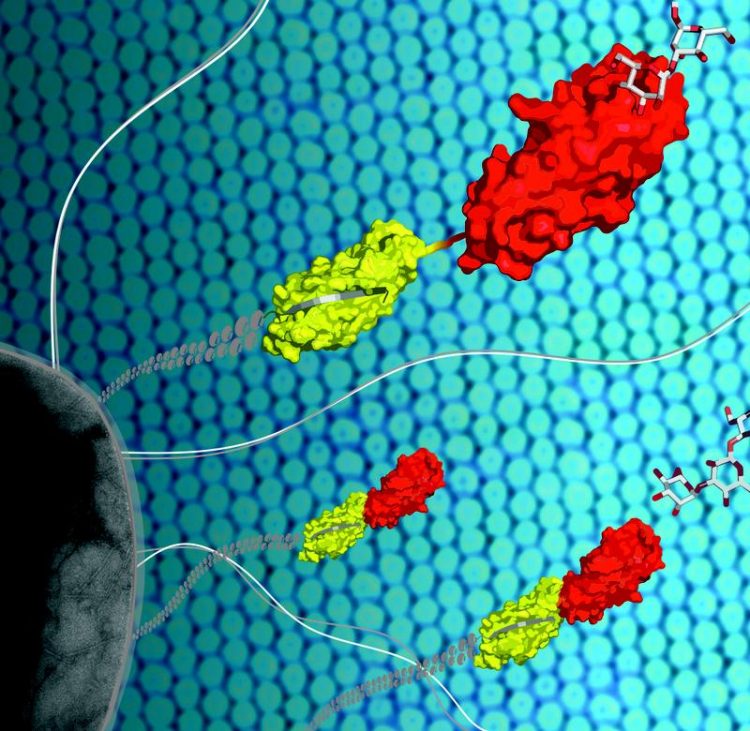Urinary tract infection: How bacteria nestle in

Using the protein FimH (yellow/red) located at the tip of long protrusions, the bacterial pathogen E. coli (grey) attaches to cell surfaces of the urinary tract. Maximilian Sauer, ETH Zürich
Many women have already experienced how painful a bladder infection can be: a burning pain during urination and a constant urge to urinate are the typical symptoms. The main cause of recurrent urinary tract infections is a bacterium found in the normal flora of the intestine, Escherichia coli. The bacteria enter the urinary tract, attach to the surface and cause inflammation.
The teams of Prof. Timm Maier at the Biozentrum and Prof. Beat Ernst at the Pharmazentrum of the University of Basel, along with Prof. Rudolf Glockshuber from the Institute of Molecular Biology and Biophysics at the ETH Zurich, have now discovered how bacteria adhere to the urinary tract under urine flow via the protein FimH and subsequently travel up the urethra.
Intestinal bacterium adheres to the cell surfaces with the protein FimH
The pathogen has long, hairlike appendages with the protein FimH at its tip, forming a tiny hook. This protein, which adheres to sugar structures on the cell surface, has a special property: It binds more tightly to the cell surface of the urinary tract the more it is pulled. As strong tensile forces develop during urination, FimH can protect the bacterium from being flushed out.
“Through the combination of several biophysical and biochemical methods, we have been able to elucidate the binding behavior of FimH in more detail than ever before”, says Glockshuber. In their study, the scientists have demonstrated how mechanical forces control the binding strength of FimH.
“The protein FimH is composed of two parts, of which the second non-sugar binding part regulates how tightly the first part binds to the sugar molecule“, explains Maier. “When the force of the urine stream pulls apart the two protein domains, the sugar binding site snaps shut. However, when the tensile force subsides, the binding pocket reopens. Now the bacteria can detach and swim upstream the urethra.”
Drugs against FimH to combat urinary tract infections
Urinary tract infections are the second most common reason for prescribing antibiotics. Yet, in times of increasing antibiotic resistance, the focus moves increasingly to finding alternative forms of treatment. For the prevention and therapy of E. coli infections, drugs that could prevent the initial FimH attachment of the bacteria to the urinary tract could prove to be a suitable alternative, as this would make the use of antibiotics often unnecessary.
This opens up the possibility of reducing the use of antibiotics and thus preventing the further development of resistance. Prof. Ernst, from the Pharmazentrum of the University of Basel, has been working intensively on the development of FimH antagonists for many years. The elucidation of the FimH mechanism supports these efforts and will greatly contribute to the identification of a suitable drug.
Original article
Maximilian M. Sauer, Roman P. Jakob, Jonathan Eras, Sefer Baday, Deniz Eriş, Giulio Navarra, Simon Bernèche, Beat Ernst, Timm Maier, Rudi Glockshuber
Catch-bond mechanism of the bacterial adhesin FimH
Nature Communications (2016), doi: 10.1038/ncomms10738
Further information
Prof. Dr. Timm Maier, University of Basel, Biozentrum, tel. +41 61 267 21 76, email:: timm.maier@unibas.ch
Prof. Dr. Rudolf Glockshuber, ETH Zürich, Institute of Molecular Biology & Biophysics, tel. +41 44 633 68 19, email: rudi@mol.biol.ethz.ch
Dr. Katrin Bühler, University of Basel, Biozentrum, Communications, tel. +41 61 267 09 74, email: katrin.buehler@unibas.ch
https://www.unibas.ch/en/News-Events/News/Uni-Research/Urinary-tract-infection-H…
Media Contact
All latest news from the category: Life Sciences and Chemistry
Articles and reports from the Life Sciences and chemistry area deal with applied and basic research into modern biology, chemistry and human medicine.
Valuable information can be found on a range of life sciences fields including bacteriology, biochemistry, bionics, bioinformatics, biophysics, biotechnology, genetics, geobotany, human biology, marine biology, microbiology, molecular biology, cellular biology, zoology, bioinorganic chemistry, microchemistry and environmental chemistry.
Newest articles

High-energy-density aqueous battery based on halogen multi-electron transfer
Traditional non-aqueous lithium-ion batteries have a high energy density, but their safety is compromised due to the flammable organic electrolytes they utilize. Aqueous batteries use water as the solvent for…

First-ever combined heart pump and pig kidney transplant
…gives new hope to patient with terminal illness. Surgeons at NYU Langone Health performed the first-ever combined mechanical heart pump and gene-edited pig kidney transplant surgery in a 54-year-old woman…

Biophysics: Testing how well biomarkers work
LMU researchers have developed a method to determine how reliably target proteins can be labeled using super-resolution fluorescence microscopy. Modern microscopy techniques make it possible to examine the inner workings…





















